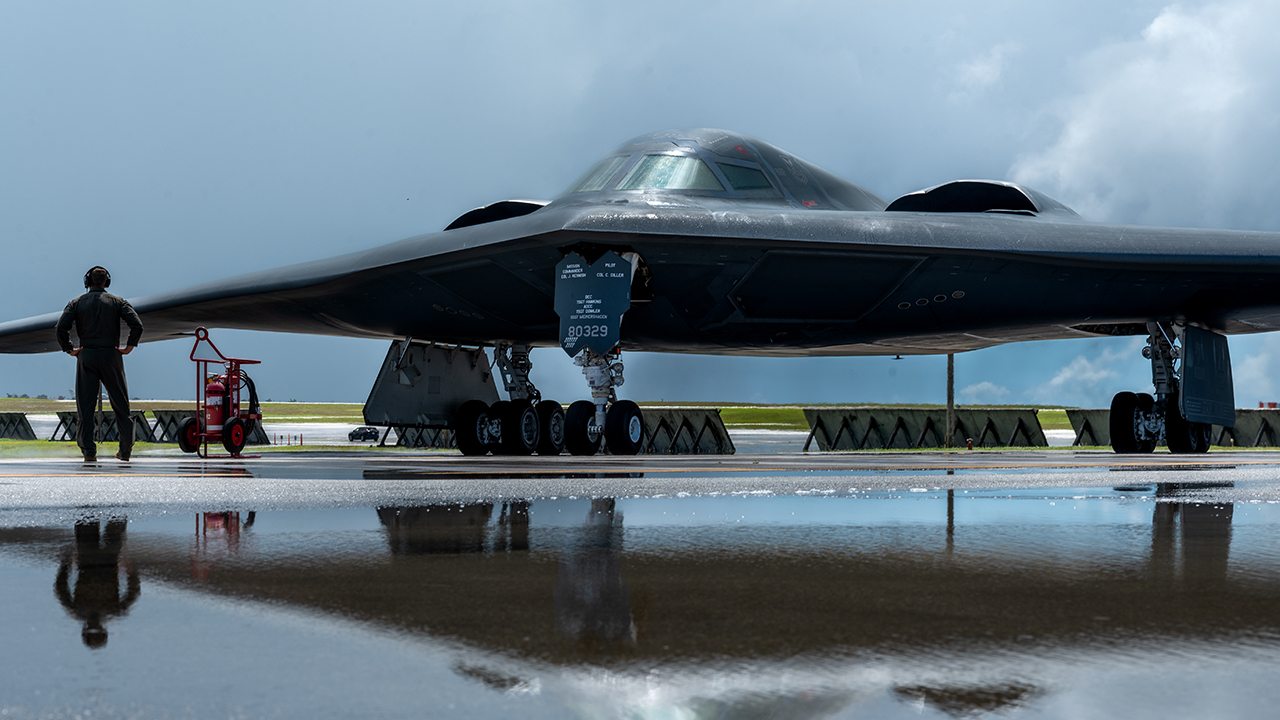U.S. Air Force B-2A Spirit stealth bombers have touched down at Andersen Air Force Base on the Pacific island of Guam for the first time since 2019, as shown in a series of images released by the Department of Defense.
Taking part in Exercise Valiant Shield 2024, which we reported on previously, three B-2A Spirit stealth bombers departed Whiteman Air Force Base (AFB) in Missouri on June 12, 2024 using the callsigns REARM 71, 72 and 73.
The third aircraft, as is common in long range U.S. Air Force bomber sorties, was designated as an airborne spare in case of any malfunction with the leading two airframes. The spare aircraft returned to Whiteman AFB prior to the oceanic portion of the flight. These lead aircraft received refueling support from KC-135s based at Hickam AFB in Hawaii.
PEARL41 flt (KC-135) cleared by OAKLAND to refuel REARM 71 flt (B-2) via CPDLC off the coast of Hawaii. 😎 pic.twitter.com/quSEjtqM2i
— Thenewarea51 (@thenewarea51) June 12, 2024
After crossing the International Date Line, REARM 71 and 72 were joined on June 13 by U.S. Air Force F-22A Raptor and U.S. Marine Corps (USMC) F-35B Lightning II stealth fighters, which flew in formation with the bombers for a photo exercise, or ‘PHOTEX’, from a USMC KC-130.
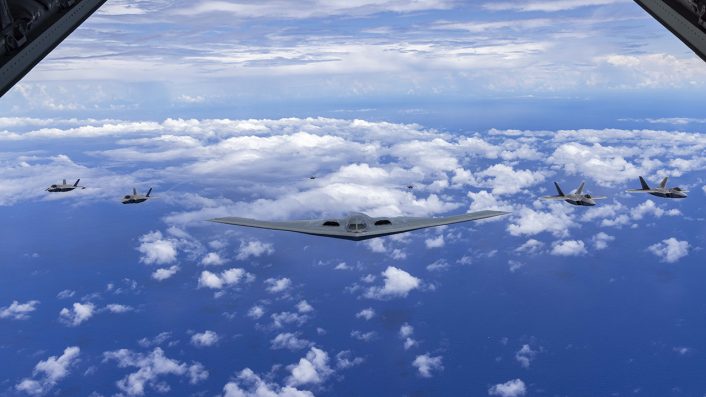
Commenting on the fielding of the B-2 Spirit in the exercise, a U.S. military statement read: “The speed, flexibility, and readiness of our strategic bombers plays a critical role in our ability to deter potential adversaries and signal our unwavering support to our allies and partners.”
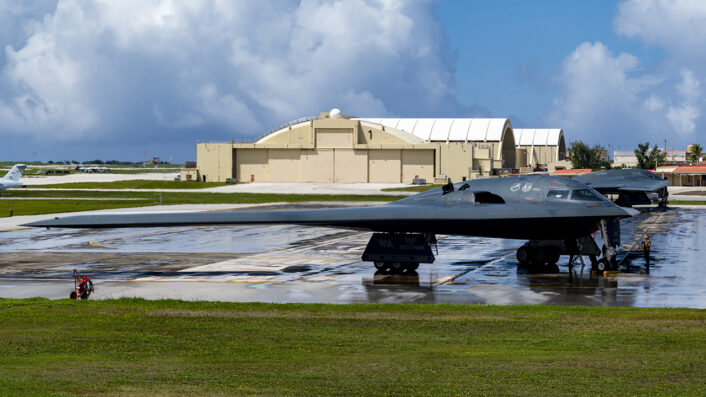
Noteworthy, the U.S. has beefed up its presence at Andersen AFB with the deployment of B-1B bombers to support a BTF (Bomber Task Force) mission in the Indo Pacific region.
A @PACAF B-1B bomber arrives to support routine #BomberTaskForce missions, demonstrating the #Readiness of #USINDOPACOM postured assets to respond in support of #FriendsPartnersAllies in the #FreeAndOpenIndoPacific.
📍 #Guam
📸 SSgt Jake Jacobsen pic.twitter.com/knsMqYFryY
— U.S. Indo-Pacific Command (@INDOPACOM) June 19, 2024
B-2s Overseas
While there has not been a publicly acknowledged visit of a B-2 Spirit to Guam since 2019, Andersen AFB remains one of only three strategically positioned bases outside of the continental United States fully equipped to support the stealth bomber’s unique requirements. The others are RAF Fairford in the United Kingdom, and Diego Garcia, a United Kingdom overseas territory in the Indian Ocean.
RAF Fairford and Andersen AFB both feature hangars very similar to those used at Whiteman AFB, where each airframe is kept in its own individual climate-controlled hangar to preserve the fragile stealth coating.
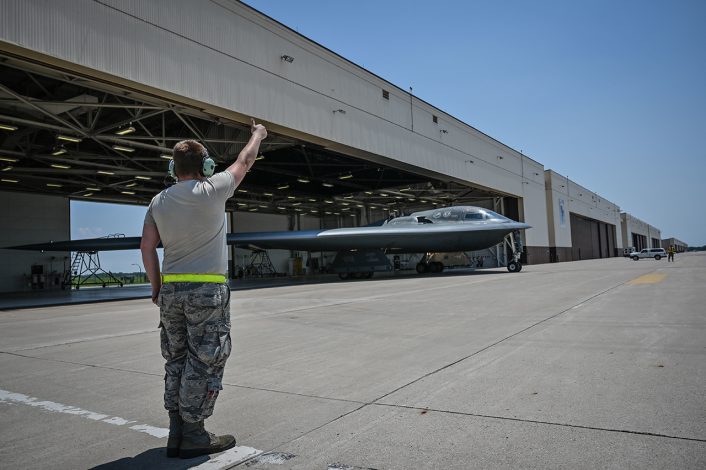
At RAF Fairford an additional hangar was constructed to a design referred to as the B-2 Shelter System or B2SS. This is a distinctive clam-shell type hangar with a PVC outer skin, designed to be more rapidly deployable than traditionally built structures. The B2SS was developed in the early 2000s and in testing was able to be shipped by air and constructed at a forward operating location in around 70 days.
Four B2SS hangars are permanently deployed to Diego Garcia, and are likely used in place of the Whiteman AFB style hangars employed elsewhere.
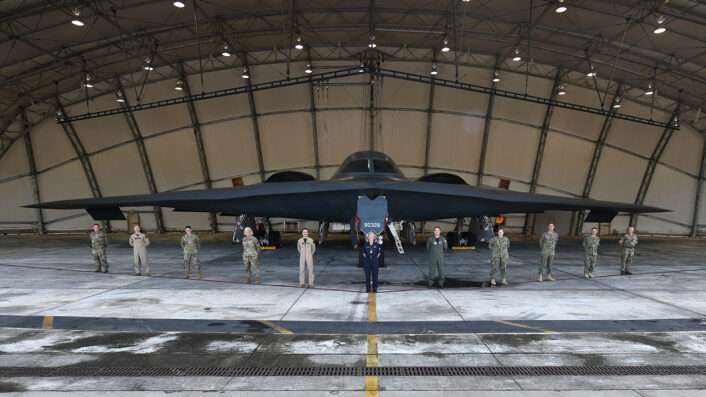
These locations have clearly been chosen with great care to provide the B-2 force with an adaptable and robust global strike capability. Andersen AFB is a perfect launching point for operations in Asia and the Pacific, NSF Diego Garcia is strategically located for access to the Middle East and Africa without being so close as to be vulnerable to attack, while RAF Fairford can support operations in the European, African and Middle Eastern theaters.
Of course, utilising the U.S. Air Force’s large aerial refueling fleet, B-2s can and do also operate long-range strike sorties directly from Whiteman AFB.
In more recent years we have also seen the B-2 fleet increase their use of other airfields for deployments and stop-overs, notably Keflavik in Iceland and Lajes Field in the Azores. The Keflavik deployment was noteworthy for being the first overseas deployment for the B-2 force following a lengthy five month pause in operations, following a December 2022 incident which saw one of the then twenty airframes suffer a fire after making an emergency landing. The U.S. Air Force later announced that a B-2 airframe would be divested from the fleet, reducing the total number in service to nineteen out of twenty-one delivered.
The previous hull-loss incident occurred in 2008 at Andersen AFB, while a B-2 landing incident in 2021 ended in the mishap aircraft being repaired by Northrop Grumman at Palmdale in California.
An April 2023 G.E. image of USAF Plant 42 at Palmdale shows what is likely B-2A 89-0129 “Spirit of Georgia”. It arrived there in September 2022 for repairs a year after a runway excursion at Whiteman AFB, Missouri. 1/5 #planespotting #avgeek #aviationdaily #aviationlovers #milair pic.twitter.com/9flyhYtCbs
— GEOAvia (@bclemens) December 13, 2023
One motivation for taking the option to retire the airframe rather than repair it may have been the impending entry to service of the B-21 Raider, which is currently in active flight testing. The B-21’s newer generation stealth coating is said to be much more resilient than its predecessor’s, allowing a greater flexibility in terms of which forward operating locations they may be able to deploy to.
This improvement in radar-absorbing material (RAM) technology would follow what we see with smaller, tactical stealth aircraft. The F-117 Nighthawk famously used climate-controlled hangars just like the B-2 Spirit, and they continue to operate from these hangars at the Tonopah Test Range Airport to this day. The F-22 Raptor featured a more durable coating, although it still requires a lot of care to maintain. The F-35 improves on this durability again, and the coating itself is still evolving according to new developments.
Despite the improvement in durability, allowing for a greater flexibility in terms of the airfields the B-21 Raider could use for long-term deployments, we are unlikely to see Andersen AFB, NSF Diego Garcia and RAF Fairford say goodbye to stealth bombers. Their aforementioned strategic locations, as well as all of the security and munitions handling infrastructure in place, will almost guarantee their continuing use by Air Force Global Strike Command.

